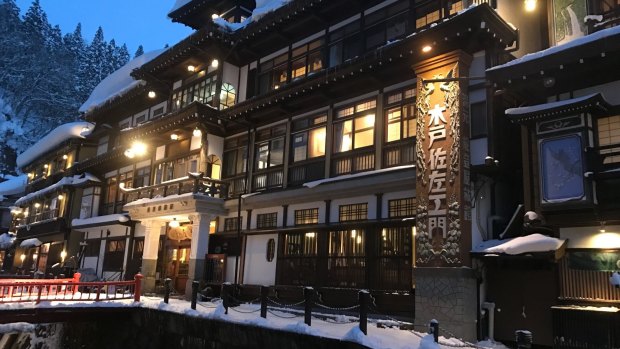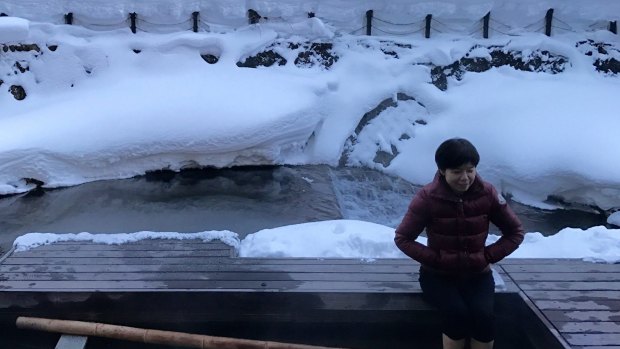This was published 5 years ago
Visiting Japan's legendary onsens: Claimed to be the source of healing powers
By Julie Miller

The beautiful onsen town of Ginza in Yamagata prefecture.Credit: Julie Miller
Snow has been falling for several hours, flakes so luscious you can see the delicate crystal formations. The houses below the window of my ryokan (traditional Japanese inn) have a metre of snow piled on their roofs; while the branches of deciduous trees resemble frosty ice wands, frozen in time by the white witch of Narnia.
Through the mist a mountain slope looms, the remnant of a volcano that exploded 10,000 years ago, creating the caldera where the hamlet of Hijiori nestles.
Meanwhile, magma deep below the dormant Mt Gakkan fires up hot springs, pushed to the surface in three separate sources. Some 1200 years ago, so legend has it, a man suffering from a broken elbow discovered these springs, the calcium-laden waters healing his fracture. Named after that fateful injury (elbow fracture), Hijiori is a hidden outpost on the onsen circuit, so remote and deep within the mountains of Yamagata prefecture on the island of Honshu that few Japanese even know about it.

Visitors to Hijori can soak their feet in one of its many open-air footbaths.Credit: Julie Miller
Only 320 people call Hijiori home; while the greater district of Okura-mura has only 3700 residents. Since the Edo period, the onsen waters have been in the hands of 36 individual owners, passed down through the generations to a designated heir. These water rights cannot be sold or transferred; no large hotel chains, for instance, can come in and buy up land and onsens. The 20-odd ryokans that offer accommodation are all part of that coveted 36; and each guest is encouraged to visit multiple bathhouses, an illustration of the strong community bond.
Recovering from a recent bone injury myself, I am curious to see if Hijiori's waters live up to their healing reputation. To test the theory, I remove my shoes and plunge my frozen feet into one of the town's many open-air footbaths, allowing the scalding water to caress the long-term bruising associated with my fractured ankle. In these sub-zero temperatures, with falling snow forming an icy crust on my beanie and coat, it's a relief to have my extremities so toasty; and I can certainly attest to my skin feeling softer and smoother, if not less discoloured, after a decent soak.
The tradition of visiting onsens for healing purposes is known as toji (literally, hot water cure), and involves staying for a period of time to absorb the healing qualities of the hot spring water. According to folklore, one of Japan's oldest springs – Dogo Onsen in Ehime Prefecture on the island of Shikoku – was discovered in 712 after an emperor observed an injured heron soaking in a pool, the bird visiting daily until its leg was completely cured. Over the centuries, Buddhist monks propagated the medicinal qualities of certain springs; whilst during the Edo period, samurai warriors would travel to onsens to heal battle wounds.
Today, there are more than 27,000 onsens across Japan; to officially qualify, a natural spring must be hotter than 25 degrees and contain at least one of 19 different minerals, including sulphur, iron and metabolic acid. Whatever your ailment, whether it be rheumatism, dermatitis, diabetes, constipation, sore eyes and even infertility, there's an onsen that's said to offer a cure.
Hakone – today a popular destination for Aussie skiers – started life as a place to cure smallpox, for instance; while Kusatsu, one of the most famous onsens in Japan, features acidic water that has a strong bacterial effect, healing scars, athlete's foot and chronic skin diseases.
But possibly the most intriguing claim is that of Onogawa Hot Springs near Yonezawa City, whose radioactive, rotten-egg stench waters are said to be so good for the skin, women who soak in the town's public baths will become as beautiful as the legendary poet Ono-no-Komachi, who visited the town 1200 years ago.
An extended stay at this onsen may be on the cards.
TRIP NOTES:
MORE
kingdom-of-winter-trip-tohoku.jp/spot/en/pref/yamagata/
FLY
JAL flies from Sydney and Melbourne daily, see au.jal.co.jp/aul/en/
STAY
Yushin no Yado Kangetsu is one of the 21 ryokans in the village of Hijiori Onsen, boasting hot spring baths on its rooftop. Rooms start from $122. See jalan.net
Julie Miller was a guest of Yamagata Tourism.
Sign up for the Traveller Deals newsletter
Get exclusive travel deals delivered straight to your inbox. Sign up now.